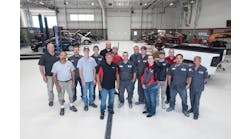In late 2018, Volvo took steps to conduct crash tests as part of the development of the Polestar 1. This represented the first time the Volvo Car Group had assessed the strength of a carbon fiber-reinforced polymer body in a real crash situation.
In contrast to a steel body, where bending helps the integrated crumple zones to reduce the amount of crash energy that reaches the vehicle’s occupants, carbon fiber dissipates energy by cracking and shattering.
I-CAR experts, including Jason Bartanen, director, industry technical relations and Mark Bochenek, director, OEM business development, meanwhile, say that carbon fiber materials being phased out will depend on whether the cost of manufacturing the material is reduced and the number of vehicles that now incorporate carbon fiber in the body and structure of the car.
FenderBender recently asked I-CAR experts for their take on the state of carbon fiber used in vehicles today.
As told to Melissa Steinken
What has been the trend for carbon fiber in vehicles? Has it been used less over the years due to steel and aluminum materials coming out?
For the past 5 years, not much has changed for the carbon fiber trend. Right now, it is used most in luxury and exotic low-volume vehicles and in areas like exterior painted panels, and limited use in body structures. The main reason for this is due to the high manufacturing costs.
Even the new Polestar 1 from Volvo will be lower volume and used as a manufacturing test bed in a similar way that BMW did with the i3 and i8 vehicles. BMW also uses carbon fiber as structural reinforcement in the 7 Series.
Repair in the 7 Series is replacement only, and the i-series vehicles have very specific repair procedures and tools required to perform the repair.
In terms of repairing carbon fiber, what are specific training requirements for a technician?
BMW, for example, requires special training for their vehicles and requires the OEM repair procedures to be followed. Makers of exotic vehicles require the use of "flying doctors" for a repair or send the vehicle to an OEM repair facility. Exterior panels need repair techniques similar to a sheet molded compound.
The training itself is typically a classroom theory with extensive hands-on, in-shop practice.


